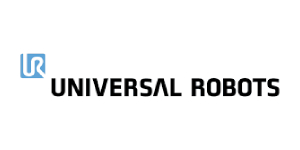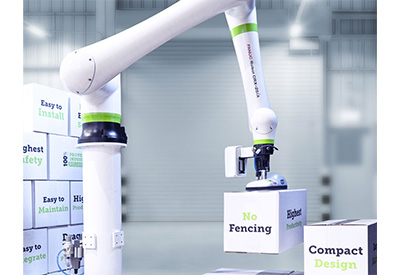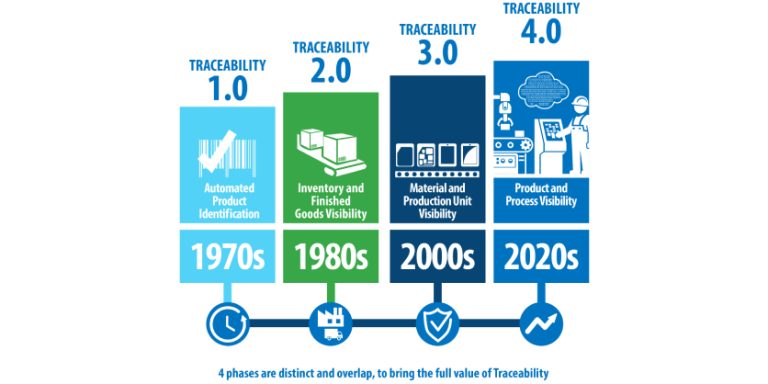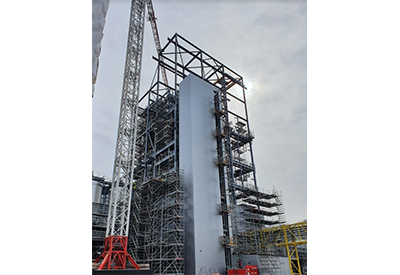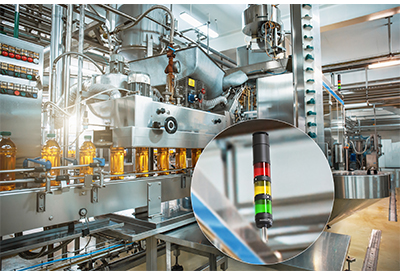10 Cobot Components – And How They Can Revolutionize Your Business
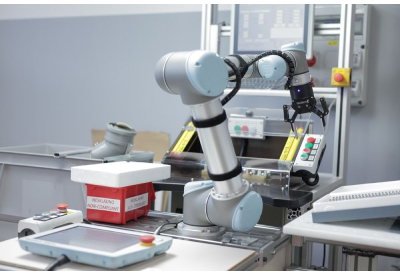
July 25, 2022
A collaborative robot (cobot) can be utilized in hundreds of ways. Whether you’re looking to automate a tedious task, increase efficiency or free your workers up to complete more technical work, cobots will be a transformative addition to your operations. Here, Universal Robots explain in more detail 10 cobot components and how they can be used within your business.
Benefits Of Cobots
There are plenty of benefits of cobots, from more efficient production and packing lines to increased employee engagement to better safety within your facility. With a different robot end effector and programming, a cobot becomes an entirely new piece of machinery. Your robotic arm has the capabilities to act as both a technical tool and manual laborer, depending on your business’s requirements. There are lots of robot components to get to grips with; here are some of the most essential or commonly used ones.
1. The Robotic Arm
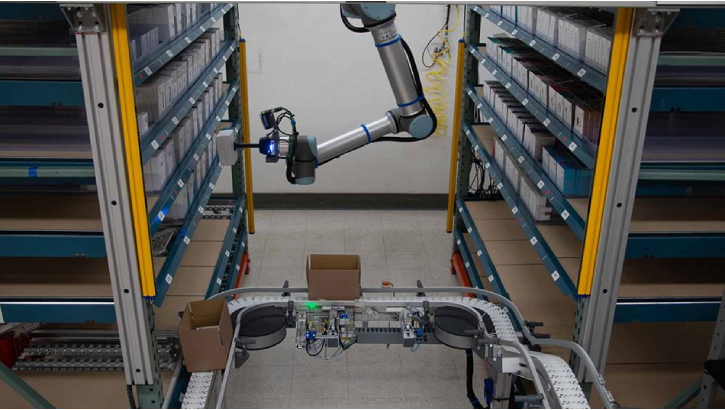
At DCL Logistics’ fulfillment centre in California, USA, the piCOBOT, a UR+ certified vacuum gripper, and a DataLogic camera that can scan multiple barcodes at the same time, picks items and places them in shipping boxes in a conveyed cell
The most important component of a cobot application, and what makes it unique, is its robot arm. Without it, companies would have to use bulky industrial robots that take up large amounts of space. For some, traditional robotics solutions may simply be out of budget and incompatible with their floorspace. Collaborative robot arms make automation and robotics accessible to a whole new audience of smaller businesses.
At Universal Robots, their focus has always been solely on perfecting the robotic arm. That’s why they have different sizes for any need: from the small tabletop UR3e to the bigger UR20we, which is great for bigger material handling tasks like palletizing. All of them have a small footprint and relatively low power requirements of a standard 110/230V wall outlet. Creating the right ‘hand’, which is known as the end of arm tooling (EOAT) or end effector, requires an entirely different set of skills. That’s why they have partnered with global third parties, many of whom offer unique or industry-leading components, through their online platform UR+.
2. Accessories
Grippers, cable guidance systems and protective covers are some of the most important accessories when it comes to protecting your cobot application, maximizing its long-term performance and ensuring the highest standards of safety.
There are two types of clamps in the cobot world. The first is a type of cobot gripper that holds items steadily in place, which could help with detailed work that requires a stable hand. The second keeps accessories like energy chains and protective hoses fixed to your cobot, which can be easily added and removed by your operatives.
3. Palletizing Tools
Monotonous tasks or ones that put your human staff at risk are best handled by a cobot. With the right tech solution and end effector, cobots can step in and tackle a range of palletizing duties. Using application-specific software, you can input the dimensions of the items your cobot will be picking up and set an exact pattern for how they should be stacked. Or you can opt for an automatic solution, which will help you get started without needing to input complex trajectory information.
If you need to move heavier goods there are accessories such as the ‘Cobot Lift’, which can increase your robotic arm’s payload from 10kg to 45kg. Although its footprint is 50% smaller than the cell of a typical industrial robot, it has similar capabilities and can typically be used without a cage or safety fence, giving you additional lifting power while saving on floor space. Plus, it works with vacuum, mechanic, electric or magnetic end effectors, allowing you to pick up a wide range of items.
4. Pick & Place Tools
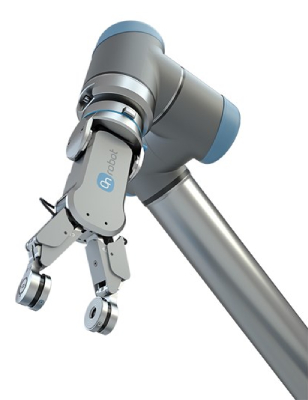
Now, pick & place end effectors are smarter than ever thanks to AI-powered machine vision. Your cobot can be trained to ‘look’ for certain items and learn to discard items that are incorrect or don’t meet the quality threshold. The beauty of a pick & place cobot application is that it can often work directly alongside its human colleagues without safety caging. Built-in sensors will detect a potential collision and automatically stop the motion of the robot if the force is above an adjustable threshold. External safety devices such as the Your cobot could be bin picking shoulder to shoulder with your people, allowing them to start their work with the right components, materials, or parts as soon as they have been sorted.
OnRobot’s UR+ certified RG2-FT gripper has accurate force sensing integrated in the gripper’s “fingertips” which improves production quality by reducing defect rates as much as 60% in delicate pick-and-place processes
5. Sander/Polisher
Polishing or sanding items to the right finish by hand is both dull and inefficient. It’s easy for a human to make a mistake, such as applying too much pressure or sanding one area too much, that can lead to damaged products and a higher risk of injury. Automated solutions like an industrial sanding belt may not be the right answer either, as they lack the finesse to finish items to a high standard such as furniture.
With a sanding or polishing end effector, you can easily automate and improve these tasks. Taking people out of the picture for simple, repeated sanding and polishing tasks will ensure a consistent result every time. The best part is that many sanding and polishing components control and adjust their applied force automatically, so you’ll get the right finish every time, even if your item is curved or flexible. Of course, you may be able to take advantage of the robot’s built-in force/torque sensor instead of opting for a more advanced external one. It depends completely on what you need your cobot application to do.
6. Grippers
Cobot grippers are incredibly versatile. Different types of grippers can transport everything from non-standard shaped and potentially hazardous products to small, breakable objects. Magnetic grippers can lift metal items, and some have variable strength, allowing the user to adjust how strong the magnetic force is based on what is being picked or moved. There are also vacuum grippers, which use suction to move cumbersome or oddly shaped items.
Some grippers have been specifically designed to handle delicate items and can adapt their grip strength to apply an appropriate amount of force to a range of items. There are even soft robotics cobot grippers that can be as gentle as a human hand, making them ideal for production lines that include fragile components or products.
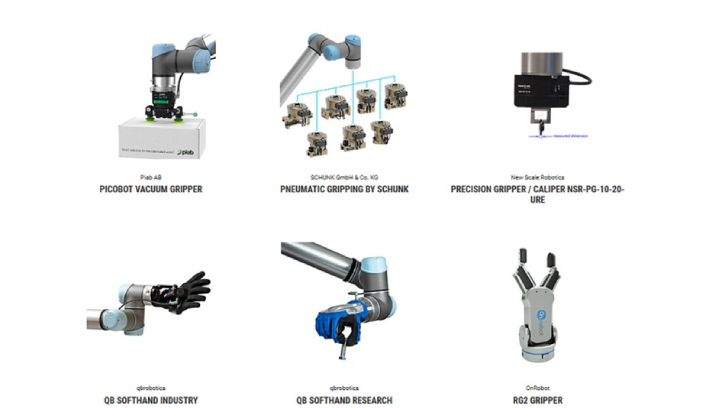
7. Measuring Sensors
A cobot does not even need to touch your goods or components to make a difference. Laser tools can take accurate measurements, even when working with difficult surfaces like high-gloss paint and glass, across a range of metrics and parameters. They can also be used to guide detailed work ensuring accuracy and quality are always maintained.
8. End of Arm Tool Changer
If versatility is a priority, a tool changer is one of the most useful cobot components to invest in. While a cobot is inherently easier to reprogram and repurpose than a traditional industrial robot, a tool changer makes it even easier for your operatives to switch your cobot to a new task. Your business may only have the budget for one cobot but have several different uses in mind – for example, using your cobot to fill any gaps that emerge on the production line, which could vary from day to day.
Some tool changers are hot pluggable, meaning your operatives can safely switch out the end effector without shutting the entire system down. This is ideal if you’d like your cobot to rapidly switch between different tasks throughout the day. Most also have a ‘one hand’ switch system, meaning end effectors click in and out or can be released by simply pressing a button.
9. Welder
Collaborative robots can handle Arc, TIG, laser, MIG, ultrasonic, plasma and spot welding as well as soldering and brazing. An end effector that is designed for welding ensures a consistent finish on all of your products. It also reduces the risk of injury to your staff, as your cobot can handle welding and soldering tasks that may require temperatures of 10,000˙F (5,538˙C) or higher. By keeping your people safe and ensuring a consistent output, you improve staff and customer satisfaction.
There are lots of welding-specific software, hardware and application kits that have been developed by our partners available through UR+. They can help companies really tailor their cobot application to their individual needs.
10. Assembly End Effectors
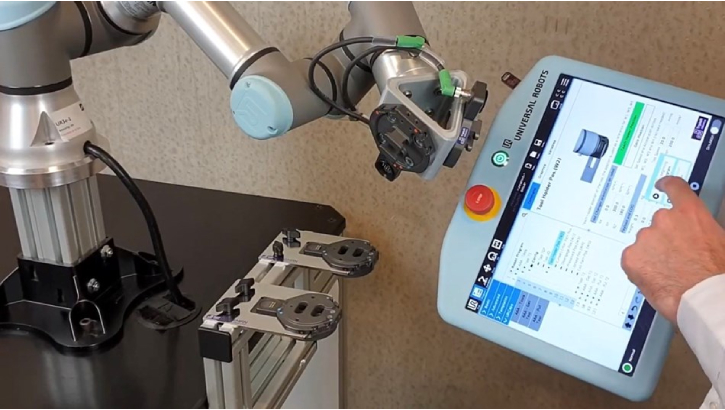
The WINGMAN Tool Changer System provides EASY automatic and manual tool change on your UR cobot
There are several robot end effectors that will come in handy on the production line. A cobot with a screwdriver, or the dexterity to tighten a nut, can take over tediously simple assembly tasks. They’re also excellent at filling capacity gaps caused by recruitment difficulties or temporary staff absences, allowing you to avoid drafting in expensive agency staff to cover. With your employees no longer shackled to the assembly line, they’ll be free to take on more thoughtful work.
Another huge benefit that comes from the versatility of cobots is the fact that you can make your own tools if you want. Even though you can choose from a huge range of readymade UR+ tools, the majority of our robots actually run with custom-made tools (mostly pneumatic). And with 3D printing becoming more and more common, it is getting simpler to make your own tool that’s perfectly fitted for your needs.
Main Takeaways
What are the main components of a cobot application? The three main components of a cobot application are the robotic arm, end of arm tooling (end effectors) and the software.
Where can I purchase new components for my cobot? If you need additional end effectors or a new piece of software, you’ll find hundreds of options within the UR+ ecosystem.
If you’d like to know more about cobots’ capabilities, get in touch with Universal Robots by clicking here

